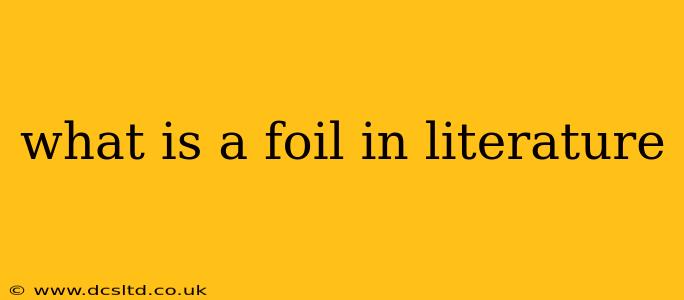A foil in literature is a character who contrasts with another character, usually the protagonist, to highlight specific qualities or traits. This contrasting character isn't necessarily an antagonist; instead, they act as a mirror, reflecting and emphasizing the protagonist's characteristics through their differences. Think of it as a literary spotlight, drawing attention to key aspects of the main character's personality, motivations, and even flaws. Understanding the foil's role deepens your appreciation of the story's themes and character development.
How Does a Foil Work in Literature?
Foils work by highlighting the differences between characters. This contrast can be in personality, values, morals, background, or even physical appearance. By placing these contrasting characters side-by-side, the author emphasizes the unique qualities of each. The foil's actions, choices, and reactions often serve to underscore the protagonist's strengths or weaknesses, making them more prominent and understandable to the reader.
Types of Foils: Exploring the Nuances
While the basic concept is straightforward, the execution of a foil can be nuanced. We can categorize foils into a few types:
-
Situational Foils: These characters share similar circumstances but react differently, thereby highlighting the protagonist's approach to a particular situation. For example, two characters facing the same challenge might choose contrasting paths, showcasing differing strengths and weaknesses in problem-solving.
-
Personality Foils: These foils differ drastically in personality. A quiet, introspective protagonist might be contrasted with an outgoing, extroverted friend. This contrast illuminates the protagonist's internal world and their preferred methods of interacting with the world.
-
Physical Foils: Though less common, physical differences can also create a foil. One character's beauty might highlight another's plainness, or physical strength might contrast with fragility, symbolizing inner strength or vulnerability.
Examples of Foils in Literature: Seeing it in Action
Many classic works utilize foils effectively. Consider these examples:
-
Hamlet and Horatio: In Shakespeare's Hamlet, Horatio serves as a foil to Hamlet. Horatio's calm rationality and steady demeanor contrast sharply with Hamlet's volatile emotions and indecisiveness. Horatio's presence emphasizes Hamlet's internal conflict and his struggles with grief and revenge.
-
Dr. Jekyll and Mr. Hyde: Robert Louis Stevenson's Strange Case of Dr. Jekyll and Mr. Hyde uses the titular characters as foils. Jekyll represents respectability and social acceptance, while Hyde embodies the darker, repressed aspects of Jekyll's personality. The stark contrast underscores the internal conflict between good and evil within a single individual.
Frequently Asked Questions about Foils in Literature
What is the purpose of a foil character?
The purpose of a foil character is to emphasize the traits and characteristics of the protagonist by providing a direct contrast. They highlight the protagonist's strengths and weaknesses, making their journey and motivations clearer to the reader.
How do you identify a foil character in a story?
Identify a foil character by looking for contrasts in personality, values, actions, and reactions to similar situations. Consider whether the character's differences serve to illuminate aspects of the protagonist's character.
Are foils always antagonists?
No, foils are not always antagonists. They can be friends, acquaintances, or even minor characters who simply offer a point of comparison to highlight specific traits of the protagonist. The key is the contrast, not the adversarial relationship.
Can a story have multiple foils?
Yes, a story can certainly have multiple foils. Each foil might highlight a different aspect of the protagonist's personality or circumstances, creating a richer and more complex portrayal of the central character.
Conclusion: The Power of Contrast in Storytelling
Foils are a powerful literary device that enhances character development and deepens the reader's understanding of the story's themes. By understanding how foils work, you can gain a more insightful and rewarding reading experience. Pay close attention to the contrasting characters in your next novel; you might be surprised by the subtle ways authors use this technique to illuminate the narrative.
